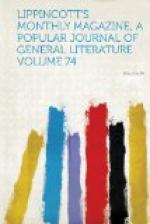The exposition is peculiarly fortunate in its site. Had historical associations determined the choice of the ground, the array of them in Fairmount Park would have sufficed to justify that which has been made. Its eminences are dotted with the country-houses of the Revolutionary statesmen and with trees under which they held converse. On one of them Robert Morris, our American Beaumarchais, enjoyed his financial zenith and fell to its nadir. To another the wit and geniality of Peters were wont to summon for relaxation the staid Washington, the meditative Jefferson, Rittenhouse the man of mathematics, the gay La Fayette with enthusiasm as yet undamped by Olmuetz, and his fellow-emigres of two other stamps, Talleyrand and the citizen-king that was to be. The house of one of the Penns looked down into a secluded dell which he aptly dubbed Solitude, but which is now the populous abode of monkeys, bears and a variety of other animals, more handsomely housed than any similar collection in America.
[Illustration: General Alfred T. Goshorn, director-general of the Centennial commission.]
Knolls not appropriated by the villas of the old time, or from which they have disappeared, offered admirable locations for some of the buildings of the exposition, and a broad and smooth plateau, situated precisely where it was wanted, at the point nearest the city, offered itself for the largest two, the Main Building and Machinery Hall, with room additional for the Art Building. The amphitheatrical depression flanked on the east by this long wall of granite and glass, and spreading northward to the heights occupied by Horticultural Hall and the Agricultural Building, was assigned to the mushroom city to be formed of the various State and foreign head-quarters, restaurants, the Women’s Pavilion, the United States Government




